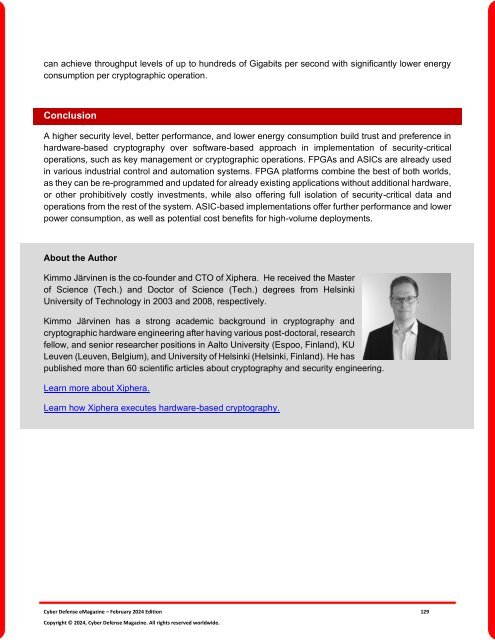The Cyber Defense eMagazine February Edition for 2024
Cyber Defense eMagazine February Edition for 2024 #CDM #CYBERDEFENSEMAG @CyberDefenseMag by @Miliefsky a world-renowned cyber security expert and the Publisher of Cyber Defense Magazine as part of the Cyber Defense Media Group as well as Yan Ross, Editor-in-Chief and many more writers, partners and supporters who make this an awesome publication! 155 page February Edition fully packed with some of our best content. Thank you all and to our readers! OSINT ROCKS! #CDM #CDMG #OSINT #CYBERSECURITY #INFOSEC #BEST #PRACTICES #TIPS #TECHNIQUES
Cyber Defense eMagazine February Edition for 2024 #CDM #CYBERDEFENSEMAG @CyberDefenseMag by @Miliefsky a world-renowned cyber security expert and the Publisher of Cyber Defense Magazine as part of the Cyber Defense Media Group as well as Yan Ross, Editor-in-Chief and many more writers, partners and supporters who make this an awesome publication! 155 page February Edition fully packed with some of our best content. Thank you all and to our readers! OSINT ROCKS! #CDM #CDMG #OSINT #CYBERSECURITY #INFOSEC #BEST #PRACTICES #TIPS #TECHNIQUES
Create successful ePaper yourself
Turn your PDF publications into a flip-book with our unique Google optimized e-Paper software.
can achieve throughput levels of up to hundreds of Gigabits per second with significantly lower energy<br />
consumption per cryptographic operation.<br />
Conclusion<br />
A higher security level, better per<strong>for</strong>mance, and lower energy consumption build trust and preference in<br />
hardware-based cryptography over software-based approach in implementation of security-critical<br />
operations, such as key management or cryptographic operations. FPGAs and ASICs are already used<br />
in various industrial control and automation systems. FPGA plat<strong>for</strong>ms combine the best of both worlds,<br />
as they can be re-programmed and updated <strong>for</strong> already existing applications without additional hardware,<br />
or other prohibitively costly investments, while also offering full isolation of security-critical data and<br />
operations from the rest of the system. ASIC-based implementations offer further per<strong>for</strong>mance and lower<br />
power consumption, as well as potential cost benefits <strong>for</strong> high-volume deployments.<br />
About the Author<br />
Kimmo Järvinen is the co-founder and CTO of Xiphera. He received the Master<br />
of Science (Tech.) and Doctor of Science (Tech.) degrees from Helsinki<br />
University of Technology in 2003 and 2008, respectively.<br />
Kimmo Järvinen has a strong academic background in cryptography and<br />
cryptographic hardware engineering after having various post-doctoral, research<br />
fellow, and senior researcher positions in Aalto University (Espoo, Finland), KU<br />
Leuven (Leuven, Belgium), and University of Helsinki (Helsinki, Finland). He has<br />
published more than 60 scientific articles about cryptography and security engineering.<br />
Learn more about Xiphera.<br />
Learn how Xiphera executes hardware-based cryptography.<br />
<strong>Cyber</strong> <strong>Defense</strong> <strong>eMagazine</strong> – <strong>February</strong> <strong>2024</strong> <strong>Edition</strong> 129<br />
Copyright © <strong>2024</strong>, <strong>Cyber</strong> <strong>Defense</strong> Magazine. All rights reserved worldwide.

















